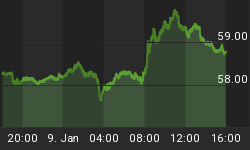In both gold and silver, the New Year brings technical readings as oversold as those seen in the 1980-1982 bear market. Some technicians claim that they have never seen such oversold conditions in the mining equities -- a pretty strong statement when you think about past bear markets in the mining stocks. In the gold market, ETF holdings, by some measures, are as low as early 2008 -- before the financial crisis. Speculative positions on electronic futures platforms are also at lows not seen in over eight years. From the perspective of Wall Street, hedge funds, and other western commercial banks, it really looks as though the 2008 crisis is a distant memory. We can all just go back to making fortunes in the conventional stock markets and forget about the need for those barbarous, inconvenient, bulky hedges like gold and silver.
Yes, complacency reigns, as more and more people focus on the recovery (at least according to official data) here at home in the United States. This complacency has likewise triggered a parabolic move in the conventional stock market -- although I admit that parabolic moves can last longer than anyone thinks possible. Yes, there is a longer term question as to whether or not we are seeing a secular bear market in gold and silver, coupled with a secular bull market in equities (think 1980s and 1990s). Still, the conventional stock market is seeing overbought technical readings consistent with prior market peaks (whether or not the longer term picture remains positive for equities.) For the intermediate term, there is no question in my mind that if you are a seller of gold and silver here you are selling at or near the bottom- while if you are a buyer of stocks you are buying at or near the top. The fact that the increase in the S&P 500 last year almost exactly mirrored the decline seen in the gold market may also tell you something about the irrational hopes of those who are mindlessly, breathlessly simply chasing the most recent, hottest investment trend. You would do well to try to buck that trend, even if it takes time for you to be rewarded.
The swing in sentiment towards deeply bearish expectations for the precious metals is further seen in 2014 forecasts for the metal released by major banking firms like HSBC, Deutsche Bank, or Societe Generale. From what I have seen coming from analysts, none are expecting an average silver price of much above 20 dollars (and many think gold will actually drop to below 1100.) Of course, these kinds of predictions should be read as a contrarian indicator. Looking at outlook coverage from the major banks, the comparisons to the start of 2013 are striking. In spite of what some may now be saying -- none of the major analysts saw the 2013 precious metals crash coming. Now, in 2014, they are back to their old ways of predicting ever lower gold and silver prices. Sound like a reason to bail on the metals?
Then there is the issue of Chinese demand (particularly for gold.) It seems that few outside the country take seriously the idea that this market might be able to absorb an increasing amount of physical precious metal. A lot of commentary that I read seems to treat China's record 2013 as a one-off event, an aberration. Many analysts seem to forget that when one billion people are being told by their government to acquire real physical metal, that this fact alone could lead to one nation absorbing all known above ground surpluses of a metal gold or silver in relatively short order.
I have already commented on the disconnect between western financial speculators who only see precious metals like silver as a financial asset, and those in the East (and sometimes elsewhere) who view precious metals as a real asset. As speculators continue to chase western stock markets ever higher -- and try to short the daylights out of gold and silver -- it should be remembered how potentially powerful a development like Chinese demand is. Western hotshot speculators with their algorithms might eventually have to respect real demand for real metal.
And so as 2014 dawns, we are faced with the same questions regarding the future of precious metals that confronted us in 2013. Are western speculators capable of dumping more precious metals? Will gold and silver continue to break lower if an index like the S&P continues its march higher? Was the white-hot physical demand for coins and bars seen in 2013 really just a one-off event, the last hurrah for a dead precious metals bull? I will leave it for you to further decide if the fundamentals that got us to 1900 dollar gold and 48 dollar silver are no longer in place, or if these fundamentals have fully expressed themselves in precious metals prices.
But I want to make one point clear. The last time that the precious metals sector was as oversold as the general equity market was overbought was around the year 2000.
And I think you know how that turned out.















